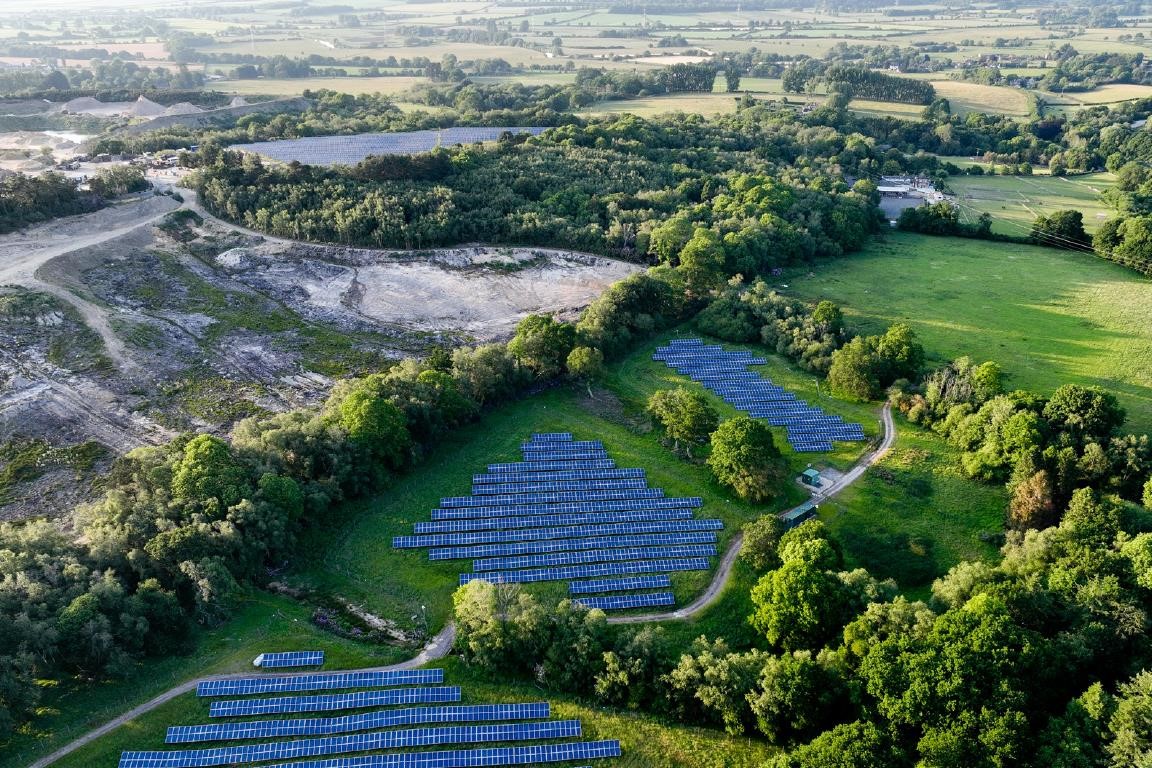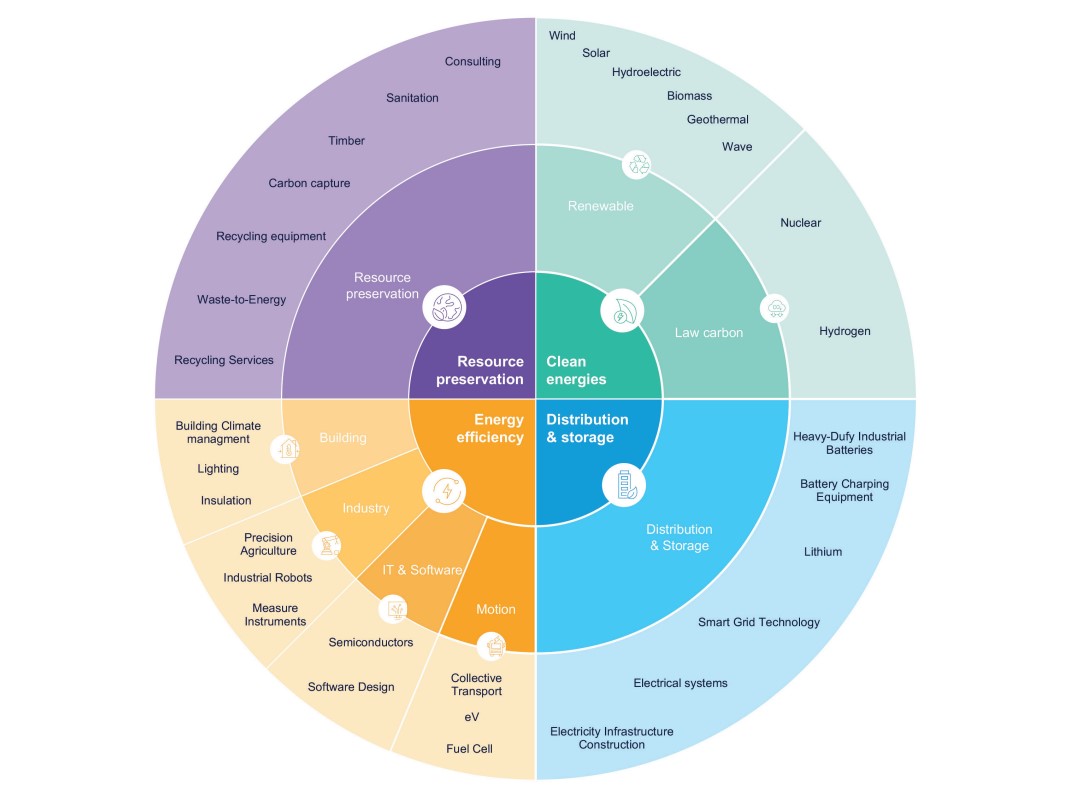Climate transition or climate solution two definitions, one objective
To achieve the goals of the Paris Agreement, greenhouse gas emissions must be reduced drastically in all economic sectors, but it is also necessary to finance technologies that will help decarbonate the economy of tomorrow.
Climate scenarios do encompass these dual challenges, which explains why some sectors, such as heavy industry and transport, are accelerating their post-2030 decarbonisation trajectory. It is therefore important to distinguish transition challenges from solutionfinancing challenges, and to have clear definitions on which companies and all sustainable finance factors can rely.
This is an analysis from CPRAM, with definitions, examples, and methodological points for designing climate solutions. It will give you some insight amidst a shifting regulatory context.
Published on 10 February 2024

What exactly is a climate-transitioning company?
A climate-transitioning company is moving from a traditional economy to a greener and more sustainable economy, for example by enhancing its energy efficiency while reducing its greenhouse gas emissions per unit produced. The transition encompasses all sectors of the economy, which must improve their practices and in particular those sectors facing a big climate challenge (energy, agriculture, transport, construction, utilities, etc.). The reduction objectives must be ambitious and be inscribed in a benchmark framework. Scientific scenarios are now the starting point of any transition methodology. Companies can refer to them in setting long-term climate objectives that are sufficiently ambitious and credible, and investors can rely on them to assess whether a company truly falls within a trajectory that remains below 2°C.
There are several methodologies and metrics for analysing transition challenges, i.e., the challenges of aligning companies and/or portfolios with these scenarios for decarbonating the economy. For example, carbon-budget methodologies are based on the gradual reduction of greenhouse gas emissions, while prospective methodologies, such as temperature-based ones reflect companies’ global warming commitments. The Science Based Targets initiative, which frames, assesses and certifies companies’ commitments to combatting global warming, is coming into gradual acceptance as a standard, as it can be used to value companies’ actual actions.
Keep in mind also that the European Commission’s benchmarks – the Paris Aligned Benchmark and the Climate Transition Benchmark – are multi-sector climate transition indices based on a carbon-budget approach. In a future article we will go into greater detail on the climate transition and decarbonation of portfolios.
How to tell them apart from climate solutions?
Climate solutions are economic activities having a positive impact on the environment by supplying technologies that ease the transition towards a greener and more sustainable economy, for example, the production of energy from renewable sources such as solar or wind power. Climate solutions are concentrated in specific sectors. On the bond market, financing of climate solutions is addressed by the green bond market.
Ideally, we should be able to quantify emissions avoided through climate solutions, but this indicator is not reliably available, as it contains many methodological limits. The most obvious metric is therefore the share of revenues in activities identified as climate solutions, but there is currently no standard complete methodology to designate climate solutions.
The European taxonomy can be used to identify and classify sustainable economic activities. It has six categories, including two climate-related ones: “climate change mitigation” for climate solutions, and “energy transition” for transitioning companies. To certify each eligible activity, the taxonomy uses specific criteria such as reduction of greenhouse gas emissions or use of renewable energy sources. It is a first, important step in identifying climate solutions, for which few data are available, as this benchmark is too recent and too technical. Pending adoption, companies have been reporting very conservatively. The taxonomy eligibility indicators are very specific and granular, and extrafinancial analysts lack the data to run the numbers on a wide range of companies if those companies have not, themselves, reported to the taxonomy.
Against this backdrop, how do you designate climate solutions?
That's why we defined our own methodology for qualifying climate solutions. This one could ultimately converge towards the taxonomy European Union when data will allow it.
Our methodology includes three main steps: definition of the different families of climate solutions, selection of companies with turnover higher than 50% in climate solutions identified activities, and qualitative certification for all selected companies.
Our approach references almost 250 activities around four broad complementary themes, thus capturing a broad spectrum of climate solutions:
1.Production of renewable and low-carbon-emission energies, encompassing technologies such as solar, wind and geothermal power, as well as other sources of clean energy.
2. Transformation, storage and distribution of these energies, which are essential for guaranteeing efficient use and constant availability of renewable energies.
3.Energy-efficiency-enhancing technologies and products in key sectors such as construction, industry, agriculture and mobility, which help reduce energy consumption and optimise its use.
4.Resource preservation solutions such as water and waste management, recycling and use of biosourced materials, which contribute to more sustainable use of natural resources.
For each of these broad themes, we have drawn up our own detailed list of activities, ranging from geothermal to nuclear to batteries, high-voltage lines and robotisation. We then used a standardised classification that breaks down companies into more than 1800 segments, in order to identify which ones are relevant and select those having an associated revenues higher than 50%.
Moreover, to avoid supporting companies having climatecontroversial activities, we identified risky activities, such as fossil fuels (oil, gas and coal) and other activities having a negative environmental impact, such as the production of asphalt and cement. If a company is implicated in one of these risky activities, we undertake due diligence to certify or decertify its climate solution designation.

In addition, we analyse companies from an ESG angle to exclude those whose activities that are most harmful to the environment.
Our thorough approach, on top of the data available via the European taxonomy, has allowed us to identify companies providing climate solutions.
That’s why we feel it is essential to distinguish transition challenges from solutions, which have a complementary role to play in achieving the Paris Agreement goals.
This is especially useful for our entire climate range, as the extra-financial indicators that our portfolio managers analyse for stock-picking are not the same for a solution stock as for a transition stock.
It is also worth noting that transitioning companies and solution companies have highly complementary financial profiles and that combining them makes it possible to approach various market cycles with peace of mind.